Volleyball drills for technique passing / defense / reception
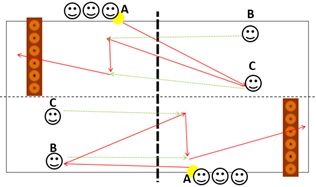
- Player A throws the ball over the net.
- Player B or C passes the ball over the net.
- The other player quickly runs underneath the net, and sets up for the same player that passed.
- This player tries to hit a cone from the bench with overarm player or a hitting movement.
Which pair or which team has hit the most cones from the bench after an X number of minutes?
Hit to outside and middle
Daarna
Beside the playmaker, the other players execute a pass, an attack, and a service.
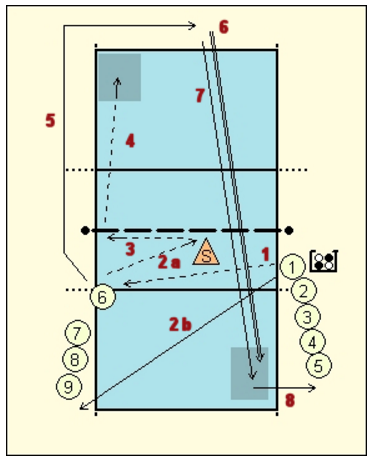
The exercise is as follows:
- 1 Player 1 throws a tight ball to player 7
- 2a player 7 passes the ball to the playmaker
- 2b player 1 walks to the other line and joins the back.
- 3 the playmaker gives a set up to player 6
- 4 player 6 smashes the ball to the mat
- 5 player 6 picks up his own ball
- 6 player 6 serves the ball to the other mat
- 7 player 6 picks up his own ball
- 8 player 6 joins the line
- This can also be done a middle attack
After 10 minutes, a block is added
- Trainers: shows basis, right leg forward, make plank, step in, etc.
- In pairs with 1 ball. Player at the net throws ball to player in the back which passes back. Is the pass correct, then play overarm, but be strict!! 20 balls, then change.
(Score keeping every good ball is a point) - Idem, only now the balls are thrown short/long, so back player has to move forwards/backwards.
- When delivering a freeball we want to disrupt the opponents offence as much as possible.
- We can also use the freeball to take out an offensive attacker by pulling them close to the net or making them take the first contact.
- Dump zones are meant to target the setter or setter transition area and to pull an outside hitter off of their approach.
- If there is time, the player passing the ball should look at the opponents side of the net to determine where to place the ball - D1, D2, D3, D4
- Teammates not involved in the play should be:
- Ready to defend the freeball
- Looking at the opponents transition or positioning on the court
- Communicating to the player passing the ball on where to put the ball - 1, 2, 3, 4
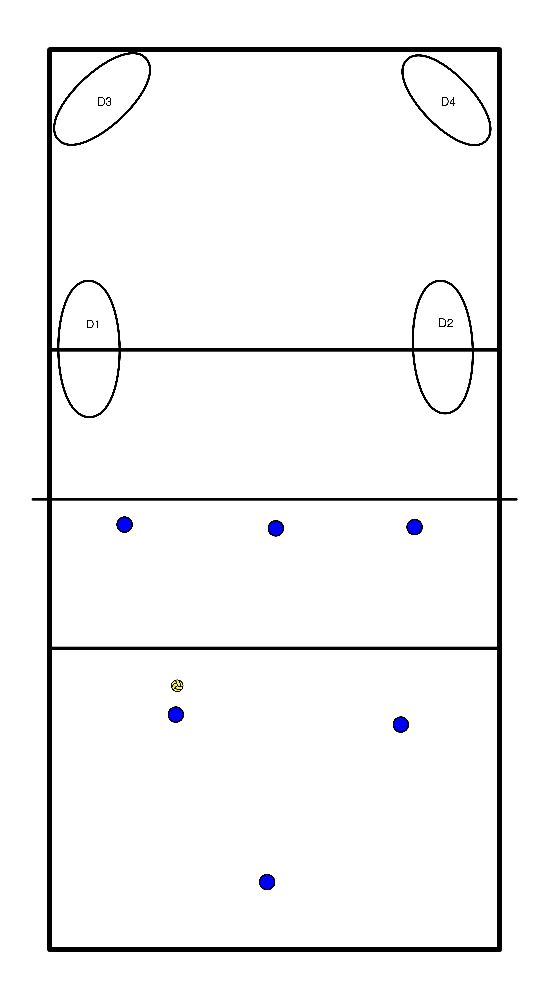
- Have 3 players walk to net, make a block jump.
- Then the players on position 3 and 4 quickly go to the 3m line, and the trainer throws a ball over the net which has to be passed to the player on position 2 (sv).
- You can still adjust by having the players first stand at the net and have them decide whether the ball should be blocked or defended.
- after the task, 3 new players in the field.
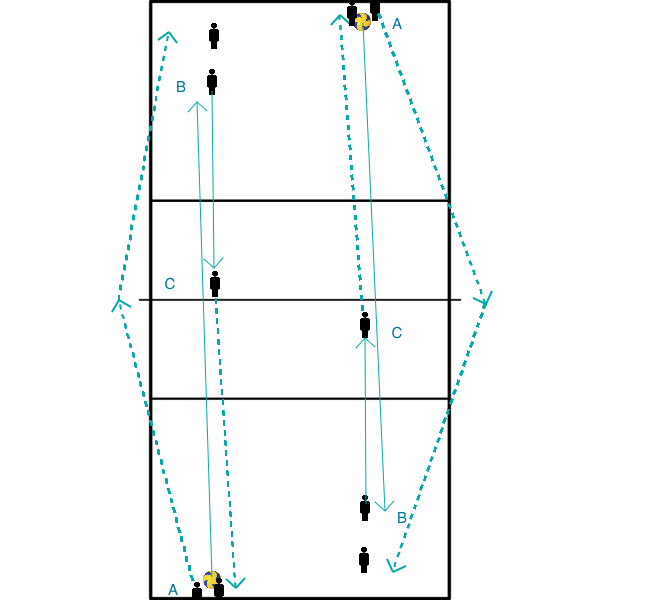
Goal: recognize ball trajectory, QUICKLY assume position.
Ball trajectory: A serves to B, B passes to C.
Walking direction: A, B, C
B moves (before the ball has passed the 3m line of A) to the right position (90%) and is active instead of reactive.
B assumes the correct posture when the ball passes the net
B adjust the correct position and posture in the remaining position (10%).
Possibly build up:
- first B catches ball with bent arms
- B then passes the ball underhand
GOAL
Condition, Feet work, Standing still and Pass
ORGANIZATION
Group of 3. A player in the middle and two others on the outer sideline.
EXECUTION
- Passer walks and shuffles backwards gives pass, turns, and shuffles backwards again for the next pass. etc...
- Pass 15 balls and change after.
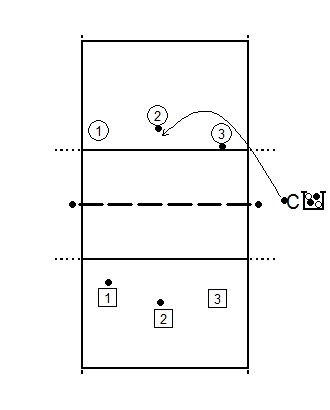
This exercise is fun in the warming-up and improves the communication between players.
- 2 teams of 3 persons.
- 2 persons of each team have a ball.
- Can also be done with 4 players and 2 balls, 3 players 1 ball, does also depend on the level of your players
- C has a ball and throws in to one of the teams.
- The goal is that the ball is played over the net in 3 times, in which each person can touch the ball once.
- The one who plays the ball, cannot hold another ball and nobody can hold 2 balls, and no ball is allowed to touch the ground.
- Emphasis is on communication (before and during the game)
- Give the assignment to the teams that they must agree on a strategy how to solve problems?
- For example, the name of the person receiving the ball is called, agreements how to play, etc.
It is a good exercise to look at the solutions the players come up with themselves to solve this difficult problem, or whether they know that to win it is useful to pass to a player who already has a ball and a guarantee for fun in the exercise :-)
- Depending on the level of your players, you can make this game harder by having the last ball calmly.
- If you play this with multiple times, then change the team that lets the ball drop for a different team.
- Teams themselves keep score, and a team scores when the other team drops the ball.
Focus of this exercise is the service pass.
Start serving calmly, raise pressure in the course of the exercise.
- A serves to B
- B passes to C
- C catches, and joins position D
- D serves or E
- E passes to F
- F catches and joins position A
Expansions:
- A takes 3 steps into the field, after the pass/set up follows a controlled straight attack, which A defends himself .
- A catches ball, and gives it to a reserve server on position A
- Idem for D
8 Players: reserve on serving position
10 players: position reserve on serving position and pass
12 players: 2 reserves serving position, 1 reserve pass position
14 players: 2 reserves on serving position and pass
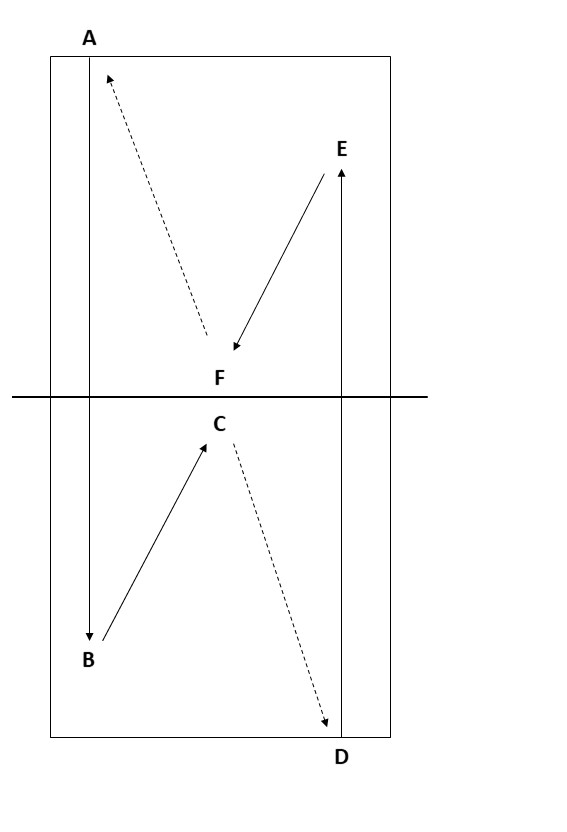
- Team of both sides field end line.
- enter the field in pairs.
- Trainer brings ball into the field and pairs have to try underhand to score with the other pair
- Winning the pair remains and lost pair joins the back of the line.
- Team with the least balls on the ground wins.
- quintet with 1 ball. 1 player is at the net
- Opposite him/her is a trio next to each other
- If the ball thrower throws a ball to the middle, the middle player passes the ball back and everybody remains.
- If the ball is thrown left, the player passes the ball back and changes left for mid
- If the ball is thrown right, the player passes the ball back and changes right for mid
Which trio keeps this up the longest.
If a ball is missed, the player that made the mistake leaves the field, and a new player comes in the middle.
To make sure that players learn to play in a rhythm, the ball has to be under way for 2 seconds each time (21-22).
- All players will try to play synchronously at the same time.
- This starts with overarm.
- The next form is that the player in the back field is going to play underhand and the player on the net overarm.
- In this way it can be extended.
he most important thing is that the players keep the ball in the air for 2 counts.







